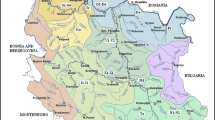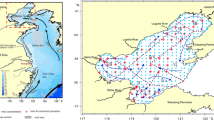Abstract
Regressions of aluminum against potentially toxic elements in the sediments of freshwater aquatic systems in Louisiana were used to distinguish natural variability from anthropogenic pollution when elemental concentrations exceeded screening effects levels. The data were analyzed using geometric mean model II regression methods to minimize, insofar as possible, bias that would have resulted from the use of model I regression. Most cadmium concentrations exceeded the threshold effects level, but there was no evidence of an anthropogenic impact. In Bayou Trepagnier, high concentrations of Cr, Cu, Pb, Ni, and Zn appeared to reflect anthropogenic pollution from a petrochemical facility. In Capitol Lake, high Pb concentrations were clearly associated with anthropogenic impacts, presumably from street runoff. Concentrations of potentially toxic elements varied naturally by as much as two orders of magnitude; hence it was important to filter out natural variability in order to identify anthropogenic effects. The aluminum content of the sediment accounted for more than 50% of natural variability in most cases. Because model I regression systematically underestimates the magnitude of the slope of the regression line when the independent variable is not under the control of the investigator, use of model II regression methods in this application is necessary to facilitate hypothesis testing and to avoid incorrectly associating naturally high elemental concentrations with human impacts.











Similar content being viewed by others
References
Buchman, M. F. (1999). NOAA screening quick reference tables: NOAA HAZMAT Report 99–1 (p. 12). Seattle: Coastal Protection and Restoration Division.
DeLaune, R. D., & Gambrell, R. P. (1996). Role of sedimentation in isolating metal contamination in wetland environments. Journal of Environmental Science and Health, A31(9), 2349–2362.
DeLaune, R., Gambrell, R. P., Whitcomb, J. H., Jones, G. L., Leach, D. E., & Wiesepape, J. (1987). Sediment analysis and sedimentation in Bayou Trepagnier. Baton Rouge, LA: Laboratory for Wetland Soils and Sediment, Center for Wetland Resources.
DeLaune, R., Gambrell, R. P., & Knox, R. S. (1989). Accumulation of heavy metals and PCBs in an urban lake. Environmental Technology Letters, 10, 753–762. doi:10.1080/09593338909384794.
EPA. (1992). Sediment classification methods compendium. Washington, D.C.: United States Environmental Protection Agency, Office of Water.
EPA. (1997). Report to congress. Washington, D.C.: United States Environmental Protection Agency, Office of Science and Technology.
EPA (2001). The Incidence and Severity of Sediment Contamination in Surface Waters of the United States, National Sediment Quality Survey (EPA number 823R0101), 2nd ed. (EPA number 823R0101) United States Environmental Protection Agency, Office of Science and Technology, Washington, D. C.
EPA. (2004). The incidence and severity of sediment contamination in surface waters of the United States, National sediment quality survey (EPA number 823R04007) (2nd ed.). Washington, D.C.: United States Environmental Protection Agency, Office of Science and Technology.
Forstner, U., & Heise, S. (2006). Assessing and managing contaminated sediments: requirements n data quality—from molecular to river basin scale. Croatica Chemica Acta, 79, 5–14.
Hou, A. X., Laws, E. A., Gambrell, R. P., Bae, H. S., Tan, M., DeLaune, R. D., Li, Y., et al. (2006). Pathogen indicator microbes and heavy metals in Lake Pontchartrain following Hurricane Katrina. Environmental Science and Technology, 40, 5904–5910.
Kennish, M. J. (1992). Ecology of estuaries: Anthropogenic effects. Boca Raton: CRC.
Laws, E. (1997). Mathematical methods for oceanographers: An introduction. New York: Wiley.
Laws, E. A., & Archie, J. W. (1981). Appropriate use of regression analysis in marine biology. Marine Biology, 65, 13–16.
Matteucci, G., Rossini, P., Guerzoni, S., Arcangeli, A., Ronti, P., Langone, F., et al. (2005). Recent evolution of sedimentary heavy metals in a coastal lagoon contaminated by industrial wastewaters (Pialassa Baiona, Ravenna, Italy). Hydrobiology, 550, 167–173. doi:10.1007/s10750-005-4374-0.
Pardue, J. H., DeLaune, R. D., & Patrick, W. H. J. (1992). Metal to aluminum correlation in Louisiana coastal wetlands: identification of elevated metal concentrations. Journal of Environmental Quality, 21, 539–549.
Ricker, W. E. (1973). Linear regressions in fishery research. Journal of the Fisheries Research Board of Canada, 30, 409–434.
Schropp, S. J., Lewis, F. G., Windom, H. L., Ryan, J. D., Calder, F. D., & Burney, L. C. (1990). Interpretation of metal concentrations in estuarine sediments of Florida using aluminum as a reference element. Estuaries, 13, 227–235.
Shannon, R. D., & White, J. R. (1991). The selectivity of a sequential extraction procedure for iron oxyhydroxide and sulfides in freshwater sediments. Biogeochemistry, 14, 193–208.
Thomas, R. L., & Meybeck, M. (1992). The use of particulate materal in water quality and assessments. In D. Chapman (Ed.),Water quality assessments (pp. 121–170). London: Chapman and Hall.
VADEQ. (2007). Fish Tissue and Sediment Monitoring Program, Virginia Department of Environmental Quality, 2007.
Windom, H. L., Schropp, S. J., Calder, F. D., Ryan, J. D., Smith, R. G. Jr., Burney, L. C., et al. (1989). Natural trace metal concentrations in estuarine and coastal marine sediments of the southeastern United States. Environmental Science and Technology, 23, 314–320.
Acknowledgements
This work was in part supported by funds from the US NOAA’s National Coastal Data Development Center at Stennis Space Center and Louisiana Department of Environmental Quality.
Author information
Authors and Affiliations
Corresponding author
Rights and permissions
About this article
Cite this article
Hou, A., DeLaune, R.D., Tan, M. et al. Toxic Elements in Aquatic Sediments: Distinguishing Natural Variability from Anthropogenic Effects. Water Air Soil Pollut 203, 179–191 (2009). https://doi.org/10.1007/s11270-009-0002-3
Received:
Accepted:
Published:
Issue Date:
DOI: https://doi.org/10.1007/s11270-009-0002-3




